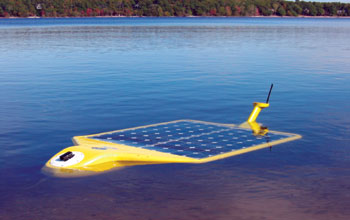Multimedia Gallery
Solar-Powered Autonomous Underwater Vehicle
Solar-Powered Autonomous Underwater Vehicle
The solar-powered autonomous underwater vehicle (SAUV) is equipped with sensors for long-term observation of chemical and biological properties of lakes, rivers and coastal oceans. Important applications include environmental monitoring and security and defense systems.
This research was supported by National Science Foundation's Division of Information and Intelligent Systems grant IIS 03-29837. (Date of Image: October 2004)
More about this Image
The RiverNet Project is designing sensor networks and systems to monitor complex or geographically large regions. Once such development is the Solar Autonomous Underwater Vehicle (SAUV). The SAUV can submerge for up to 12 hours and dive to 500 meters. It features a unique panel that allows deployment of the vehicle for weeks at a time, an on-board computer system to enable real-time mission adaptations and networked communications to support multi-vehicle cooperation.
The SAUV can be used in a variety of environmental monitoring tasks, including the detection and monitoring of hazardous events like red tides and contaminant spills, or in assessing the impact of natural events such as earthquakes and volcanoes.
A team of SAUV vehicles will be used for long-term observation of coastal and harbor regions in order to detect threats or introduction of hazardous substances. The SAUVs may also serve as an integral part of logistics for large-scale military operations with several vehicles facilitating land, sea and air coordination.
Credit: Arthur C. Sanderson, Rensselaer Polytechnic Institute; Richard Blidberg, Autonomous Undersea Systems Institute
Special Restrictions: Arthur C. Sanderson, Rensselaer Polytechnic Institute; Richard Blidberg, Autonomous Undersea Systems Institute
Images and other media in the National Science Foundation Multimedia Gallery are available for use in print and electronic material by NSF employees, members of the media, university staff, teachers and the general public. All media in the gallery are intended for personal, educational and nonprofit/non-commercial use only.
Images credited to the National Science Foundation, a federal agency, are in the public domain. The images were created by employees of the United States Government as part of their official duties or prepared by contractors as "works for hire" for NSF. You may freely use NSF-credited images and, at your discretion, credit NSF with a "Courtesy: National Science Foundation" notation.
Additional information about general usage can be found in Conditions.
Also Available:
Download the high-resolution TIF version of the image. (16 MB)
Use your mouse to right-click (Mac users may need to Ctrl-click) the link above and choose the option that will save the file or target to your computer.

